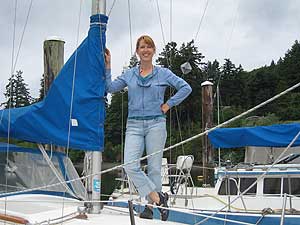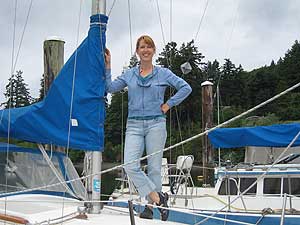Basic Sailing and Seamanship: Man Overboard
Preparation and practice your best defenses when the worst-case becomes reality.
June 2, 2008

Practice and preparation are part of sailor/author Karen Buhler Gale's (pictured above) man-overboard routine.
When the beaker from the French press fell overboard, I thought from the helm of the 33' Hunter, that's too bad. I like a cup of joe in the morning as much as the next sailor, especially after I have spent the night sleeping nose-to-eye in a double (sort of) bunk with a person I just met yesterday.
The instructor, an untamed filly with wild curly hair and a constant, maniacal look in her eyes, thought something entirely different.
"Man overboard!" she yelled.
I ducked spastically as she lunged for the man overboard pole and shot it past me like an Olympian javelin thrower. The plastic flag whacked me on the cheek as it whizzed by.
Swallowing hard and blinking so rapidly a case could be made that I had developed a nervous, really nervous, tick I delegated a spotter, got us on to a beam reach, came about and bore down on the 8-cup beaker bobbing cheerfully (and miraculously next to the pole) in the 1-foot chop. Honestly, the coffee was superfluous now. The finer, more bracing drug of adrenaline had taken hold. With the instructor now hanging over the gunwales, her ankles in the death grip of the other ashen faced female student, our circus act headed up into the wind, scooping up the beaker and pole successfully as we stalled alongside. Coffee anyone?
I couldn't decide what impressed me more: Her utter comfort (disregard) with life on the sea or my demonstrated ability in handling a sailboat well enough to retrieve a coffee beaker.
Here's my point. Practice, practice, practice man overboard drills. Today coffee beakers, tomorrow someone you love.
Check out USSailing for the Safety At Sea Studies — Crew Overboard Rescue Symposium for lots of practical, hands on lessons learned by some very committed (and cold) sailors on San Francisco Bay. Then, practice, practice, practice on your boat with your crew until you have your own life-saving list and routine.
Pay a vast amount of time and attention to the actual act of bringing someone aboard, which is, after all, the raison d'être of the drill. Practice— this is important— two scenarios: one with the victim able to assist in their own rescue (here's your chance to shine with the one-handed bowline) and the second, more difficult scenario, with the victim seriously injured or incapacitated. No good getting your boat stopped and in position only to have achieved a good view of the drowning or fatal hypothermia. So, practice. Practice getting your boat in position and practice getting the person aboard. More than your decaf, half-caf, no foam, vanilla with soy latte will depend on it.












